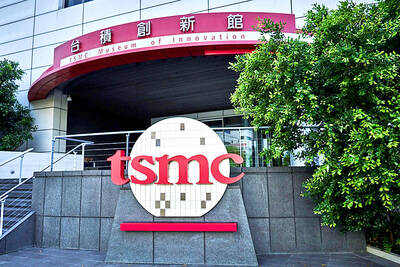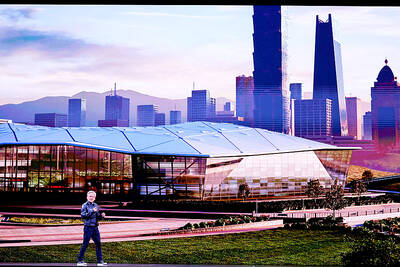Chinese telecom equipment giant Huawei Technologies Co (華為) yesterday gave foreign media a peek into its state-of-the-art facilities as the normally secretive company steps up a counteroffensive against US warnings that it could be used by Beijing for espionage and sabotage.
Huawei has started this year with an aggressive public relations campaign that has seen reclusive founder Ren Zhengfei (任正非) give a series of interviews with foreign media to deny the company is a threat, while executives have dismissed the US warnings as baseless.
The charm offensive went into another gear yesterday as Huawei welcomed media to its tightly guarded facilities in Guangdong Province.
“I don’t think this is any change in their DNA so much as a Beijing communist-style ‘we are going to pound you into submission,’” Christopher Balding, a China expert at Fulbright University Vietnam in Ho Chi Minh City, told Agence France-Presse.
Journalists toured a huge factory floor with 35 highly automated assembly lines in Dongguan, where an array of robotic arms put together a Huawei P20 smartphone every 28.5 seconds.
Reporters were then taken past rows of mammoth buildings to the Huawei Independent Cyber Security Laboratory, whose director, Wang Jin, rejected fears that the company could serve as a Trojan horse for Chinese authorities.
“Our most basic red line is that our products cannot have any back doors,” Wang said.
Foreign journalist visits are hardly routine at a headquarters where high-tech labs and manufacturing facilities employ 60,000 people, but these are unusual times for the company.
The US has said that Huawei equipment could be manipulated by the Chinese Communist Party government to spy on other countries and disrupt critical communications.
Washington is urging governments to shun the company just as the world readies for the advent of ultra-fast 5G telecommunications, an advancement that Huawei was expected to lead and which would allow wide adoption of next-generation technologies such as artificial intelligence.
Huawei chief financial officer Meng Wanzhou (孟晚舟), Ren’s daughter, yesterday faced a court hearing in Vancouver, Canada, on a US extradition request.
Two Canadians have been detained in China in suspected retaliation over her arrest.
During the tour, journalists were served coffee in cups featuring an image of a lighthouse and the words: “Lighting the way home for Meng.”
The US Department of Justice has accused Huawei and Meng of circumventing US sanctions against Iran.
Two affiliates also have been charged with stealing trade secrets from telecommunications group T-Mobile International AG.
“They should be able to ride this out,” Balding said. “It’s not realistic to expect the entire world to shun Huawei and that probably wouldn’t be good anyway.”
Founded by Ren in 1987, Huawei has espoused a relentless “wolf” ethos that executives have said fueled its rise to become the world leader in telecom network hardware.
It remains to be seen how the new charm offensive will play out, but the wolf might already smell blood.
Following intense lobbying by Huawei, reports have suggested that Britain and New Zealand might walk back earlier indications that the company would be frozen out of their telecom plans.
At the GSMA Mobile World Congress, the world’s top mobile industry fair, in Spain last week, Huawei bagged 5G commercial contracts or partnership agreements with 10 telecoms — including Switzerland’s Sunrise Communications AG, Iceland’s Nova, Saudi Telecom Co and Turkey’s Turkcell Iletisim Hizmetleri AS.
Huawei chairman Guo Ping (郭平) is today to hold a news conference at the company’s headquarters in Shenzhen that might be the real reason for the media tour’s timing.
The New York Times on Monday cited anonymous sources as saying that Huawei is to announce plans to sue the US government for barring US federal agencies from using the company’s products.
The topic of the news conference has not been disclosed, but a big announcement would allow Huawei to seize back the narrative from Meng’s extradition hearing.
Huawei declined to comment publicly on the New York Times report.
Opening its sprawling grounds is also a chance for Huawei to show that it is a global player not to be trifled with.
Its Shenzhen headquarters — near Dongguan — has cutting-edge laboratories, hotels, swimming pools and fitness centers, a dozen cafeterias and a university, where it trains staff, as well as foreign customers and partners.
Huawei strenuously denies any connections to China’s government.
However, skeptics have said that it is highly unlikely that Ren, a former Chinese army engineer, could have steered his company to such heights in such a strategic sector without the support of Beijing, which has clearly stated its goal of becoming the world’s high-tech leader.

SEEKING CLARITY: Washington should not adopt measures that create uncertainties for ‘existing semiconductor investments,’ TSMC said referring to its US$165 billion in the US Taiwan Semiconductor Manufacturing Co (TSMC, 台積電) told the US that any future tariffs on Taiwanese semiconductors could reduce demand for chips and derail its pledge to increase its investment in Arizona. “New import restrictions could jeopardize current US leadership in the competitive technology industry and create uncertainties for many committed semiconductor capital projects in the US, including TSMC Arizona’s significant investment plan in Phoenix,” the chipmaker wrote in a letter to the US Department of Commerce. TSMC issued the warning in response to a solicitation for comments by the department on a possible tariff on semiconductor imports by US President Donald Trump’s

The government has launched a three-pronged strategy to attract local and international talent, aiming to position Taiwan as a new global hub following Nvidia Corp’s announcement that it has chosen Taipei as the site of its Taiwan headquarters. Nvidia cofounder and CEO Jensen Huang (黃仁勳) on Monday last week announced during his keynote speech at the Computex trade show in Taipei that the Nvidia Constellation, the company’s planned Taiwan headquarters, would be located in the Beitou-Shilin Technology Park (北投士林科技園區) in Taipei. Huang’s decision to establish a base in Taiwan is “primarily due to Taiwan’s talent pool and its strength in the semiconductor

An earnings report from semiconductor giant and artificial intelligence (AI) bellwether Nvidia Corp takes center stage for Wall Street this week, as stocks hit a speed bump of worries over US federal deficits driving up Treasury yields. US equities pulled back last week after a torrid rally, as investors turned their attention to tax and spending legislation poised to swell the US government’s US$36 trillion in debt. Long-dated US Treasury yields rose amid the fiscal worries, with the 30-year yield topping 5 percent and hitting its highest level since late 2023. Stocks were dealt another blow on Friday when US President Donald

UNCERTAINTY: Investors remain worried that trade negotiations with Washington could go poorly, given Trump’s inconsistency on tariffs in his second term, experts said The consumer confidence index this month fell for a ninth consecutive month to its lowest level in 13 months, as global trade uncertainties and tariff risks cloud Taiwan’s economic outlook, a survey released yesterday by National Central University found. The biggest decline came from the timing for stock investments, which plunged 11.82 points to 26.82, underscoring bleak investor confidence, it said. “Although the TAIEX reclaimed the 21,000-point mark after the US and China agreed to bury the hatchet for 90 days, investors remain worried that the situation would turn sour later,” said Dachrahn Wu (吳大任), director of the university’s Research Center for